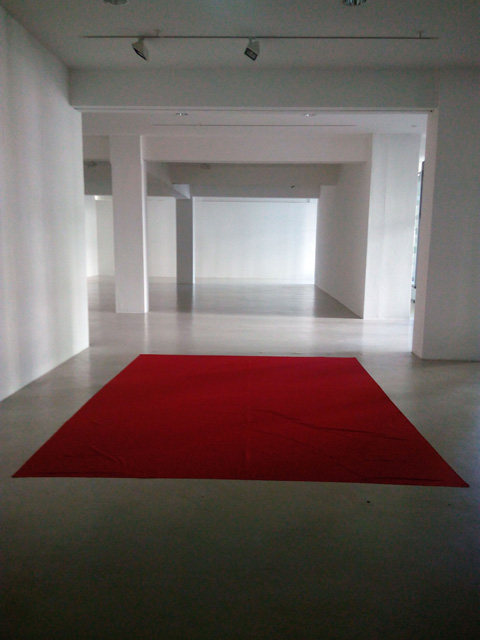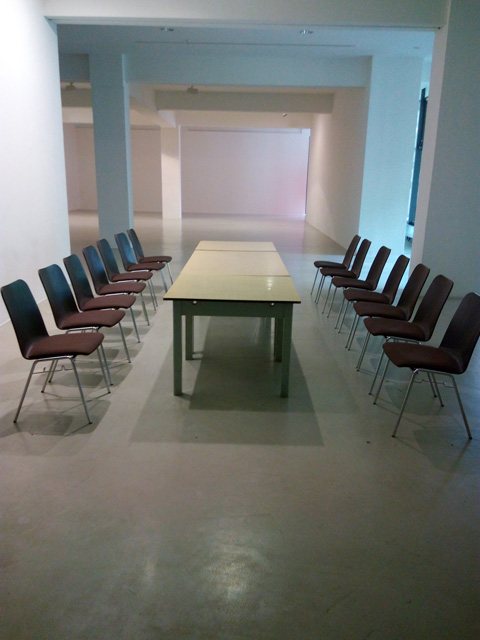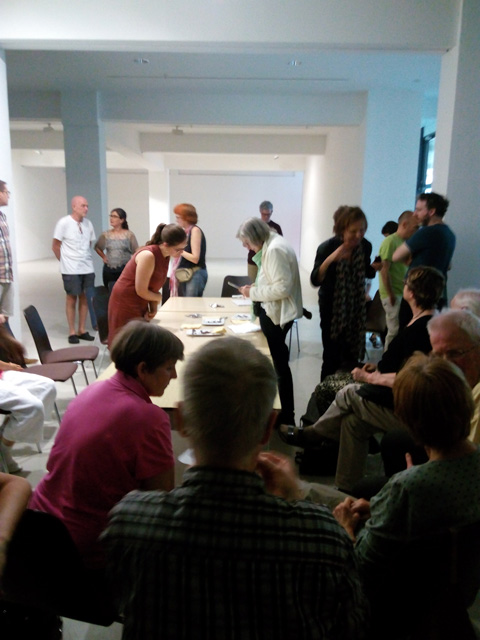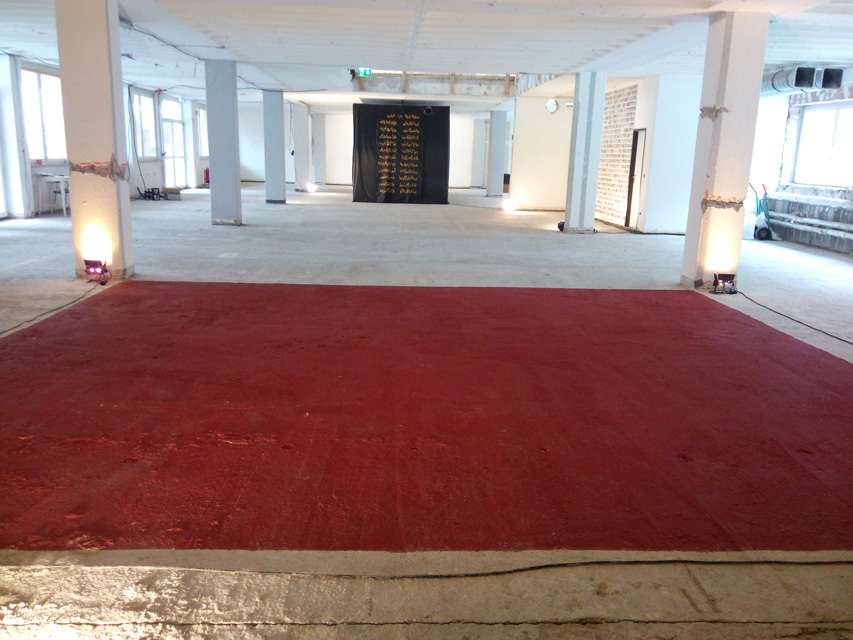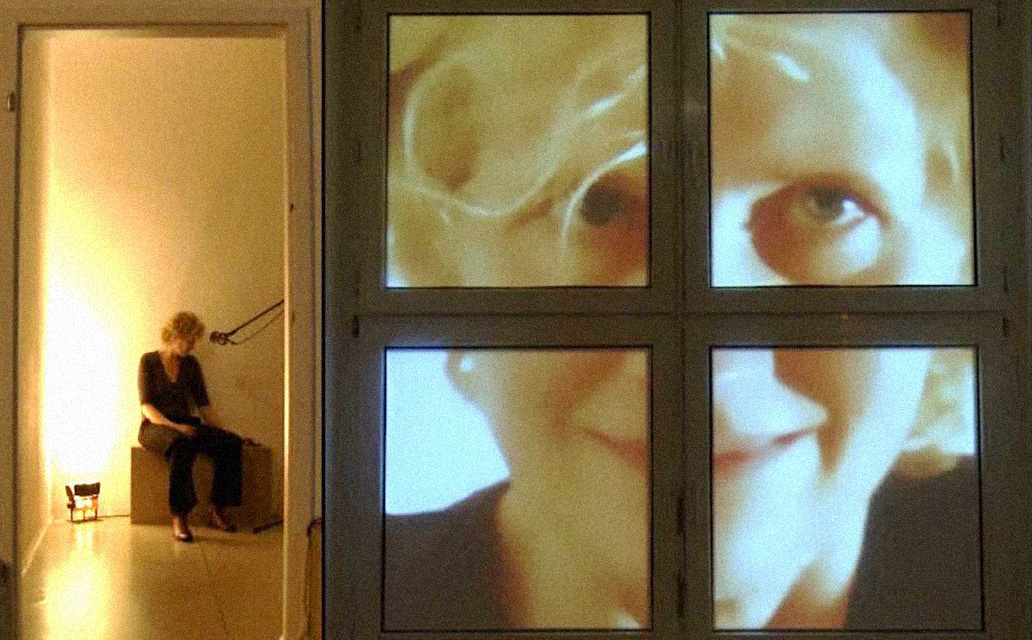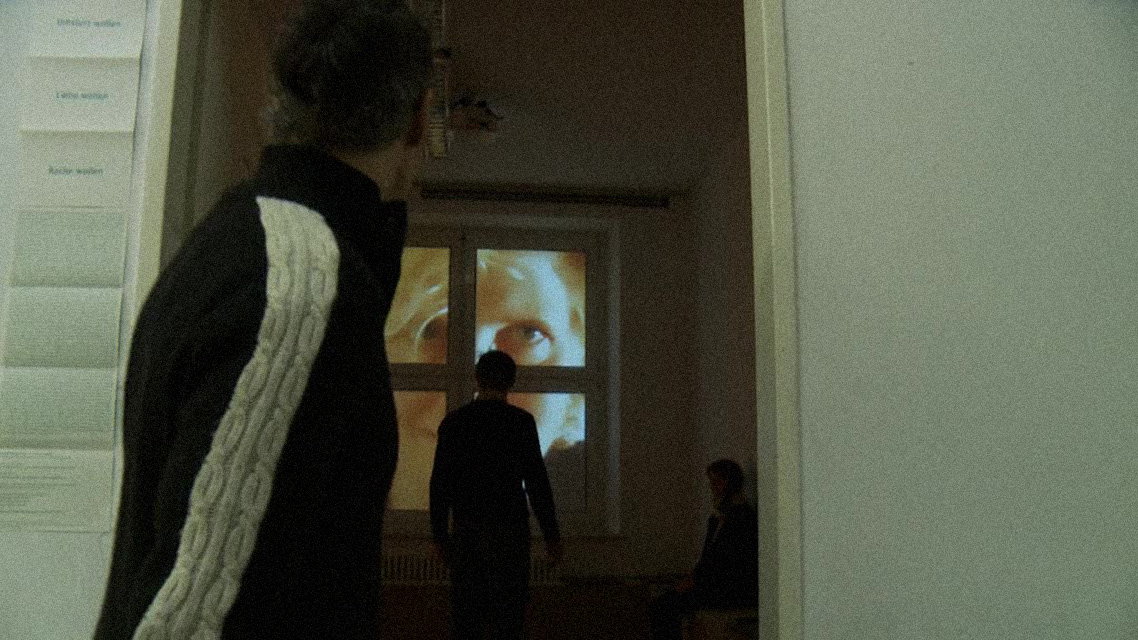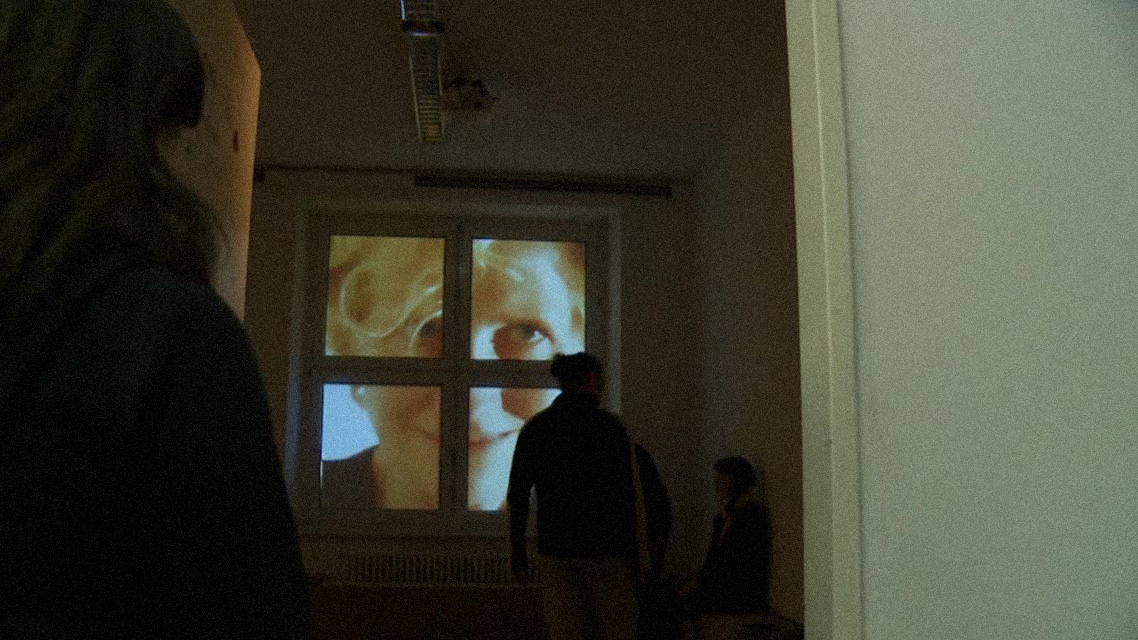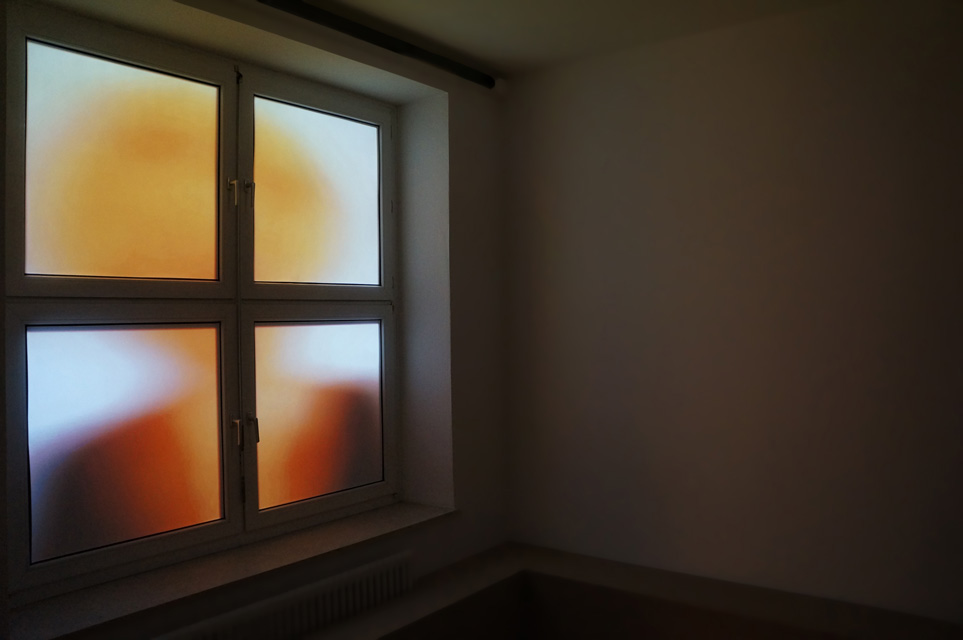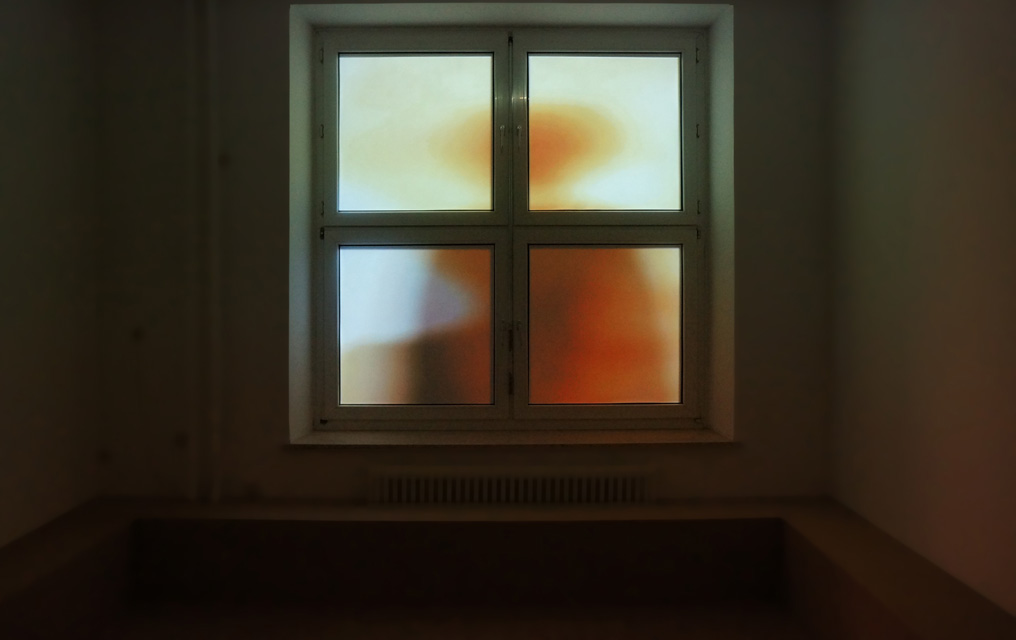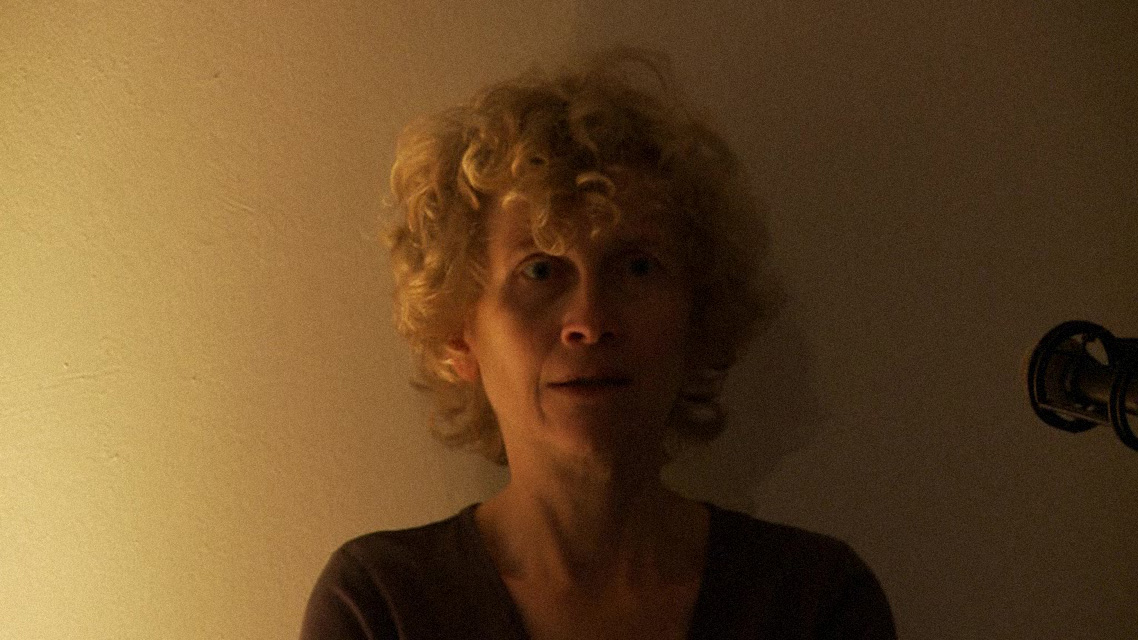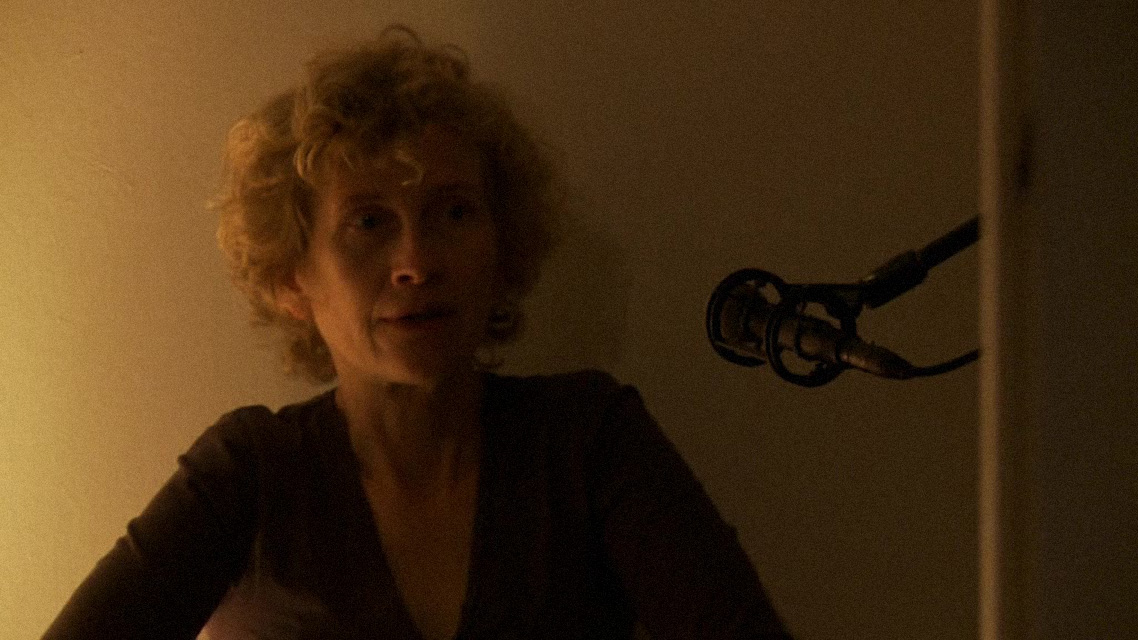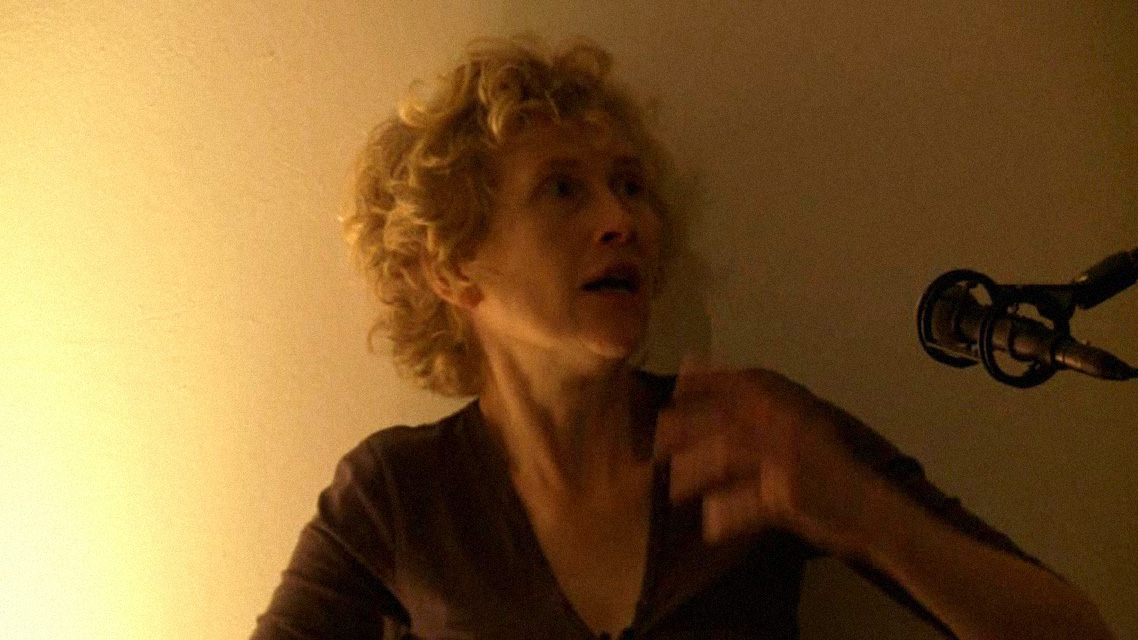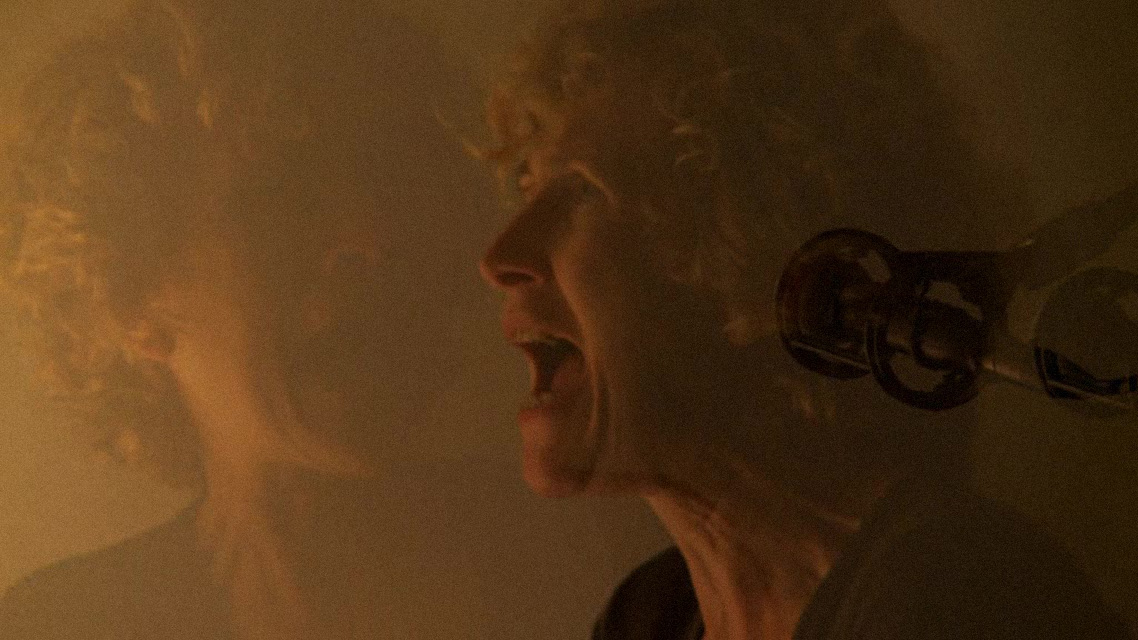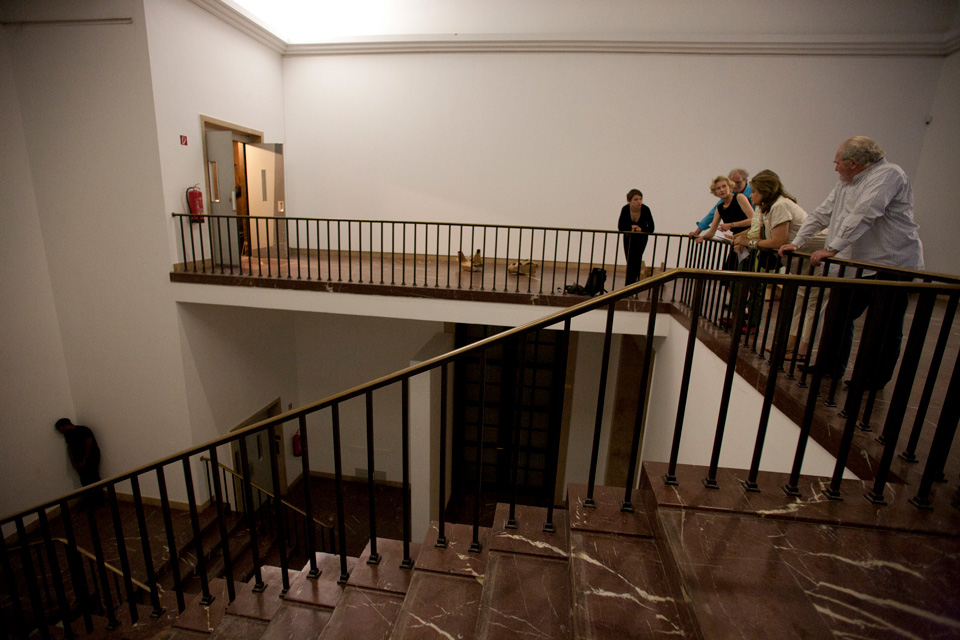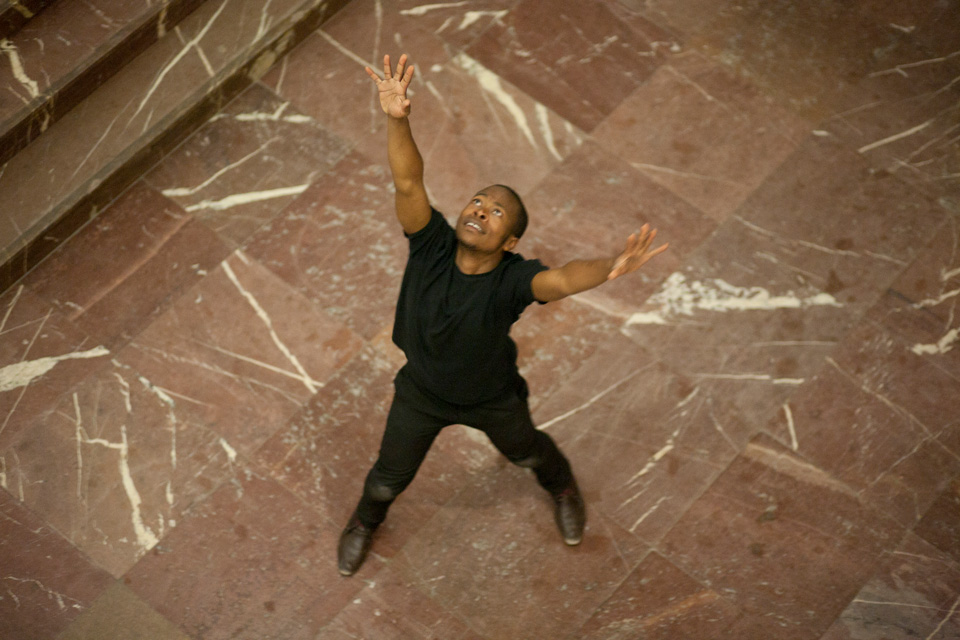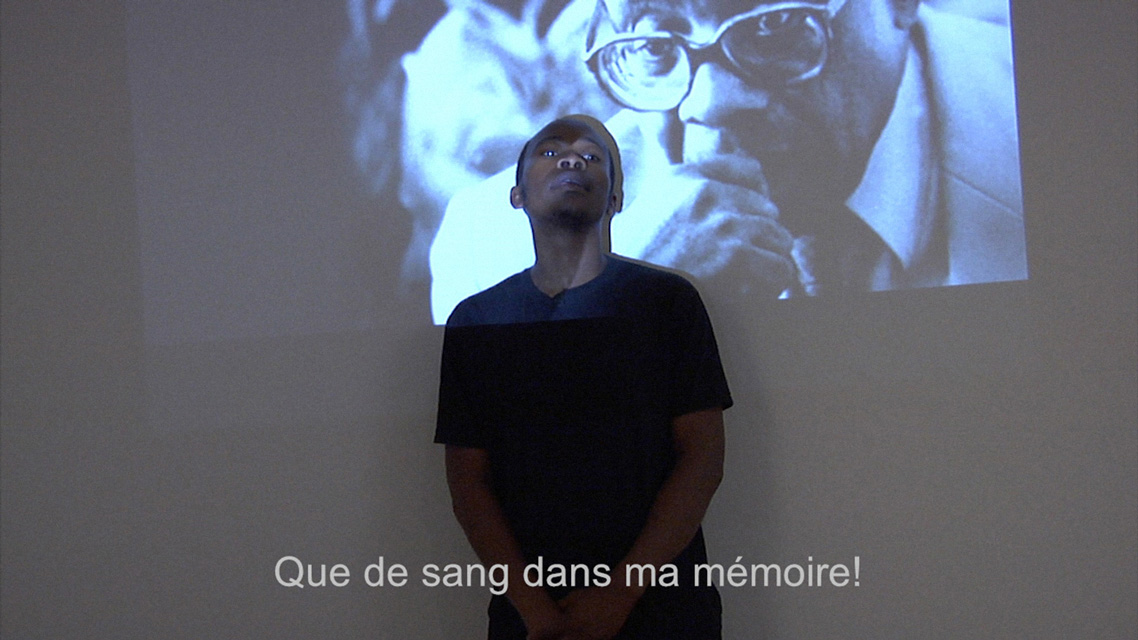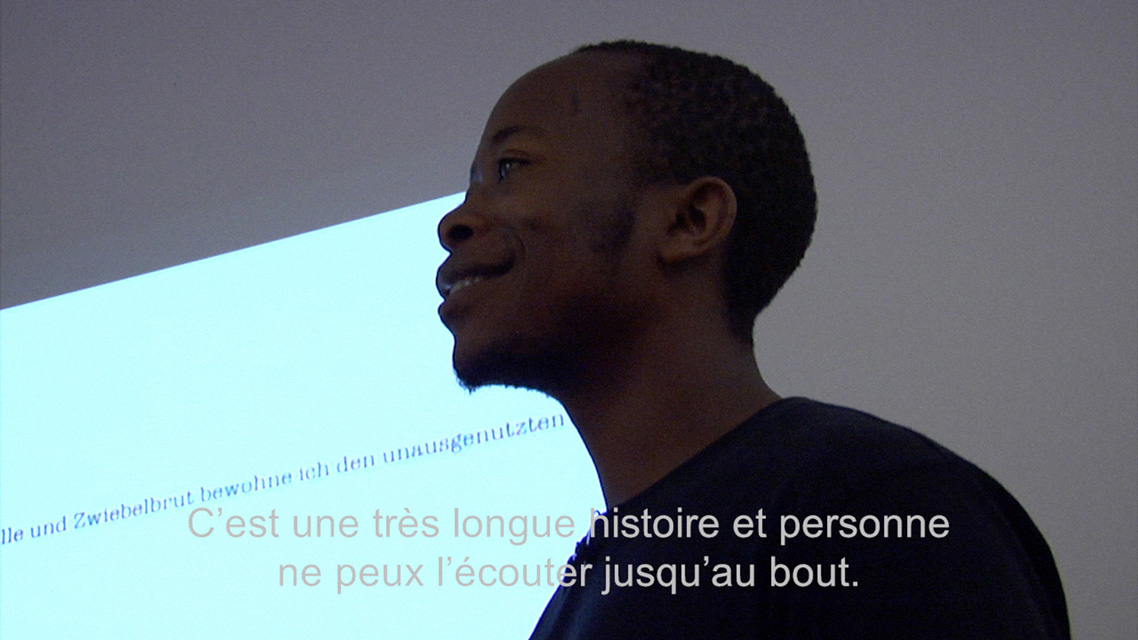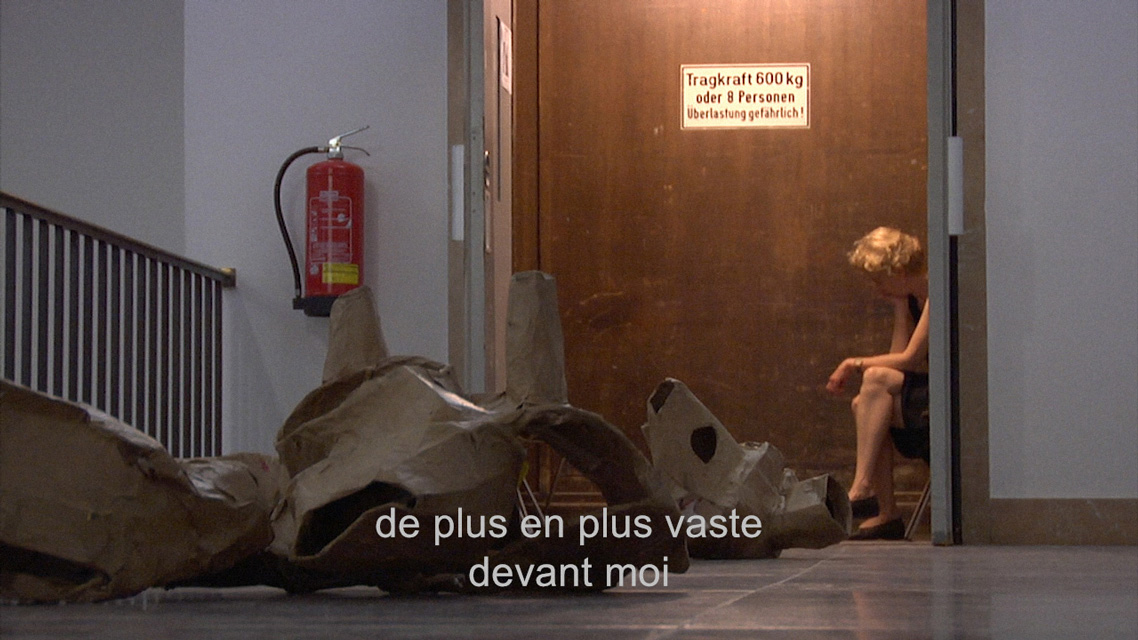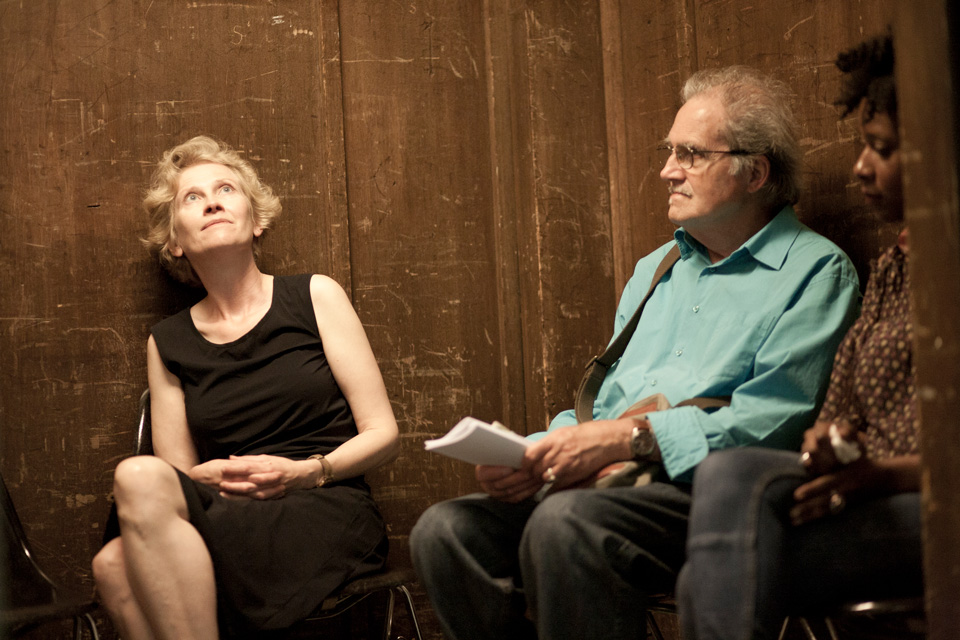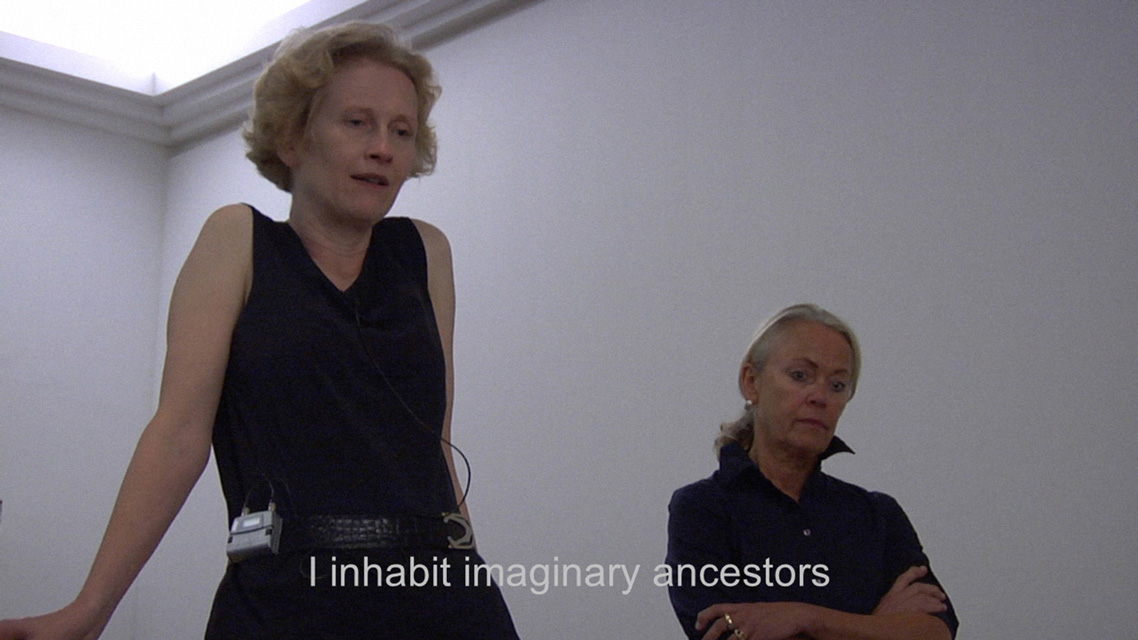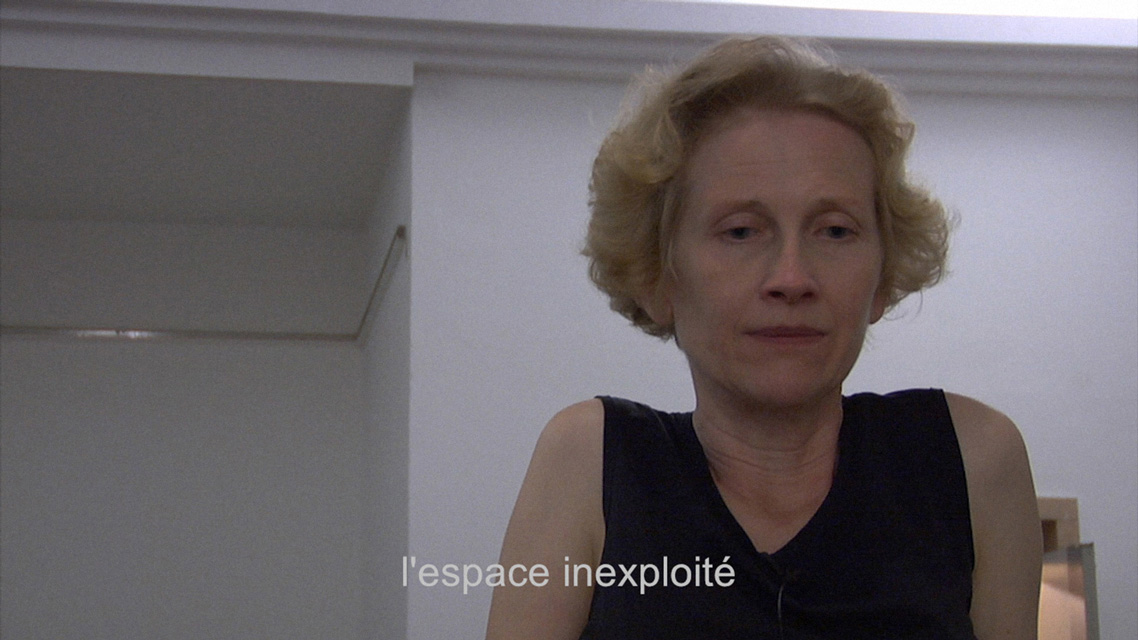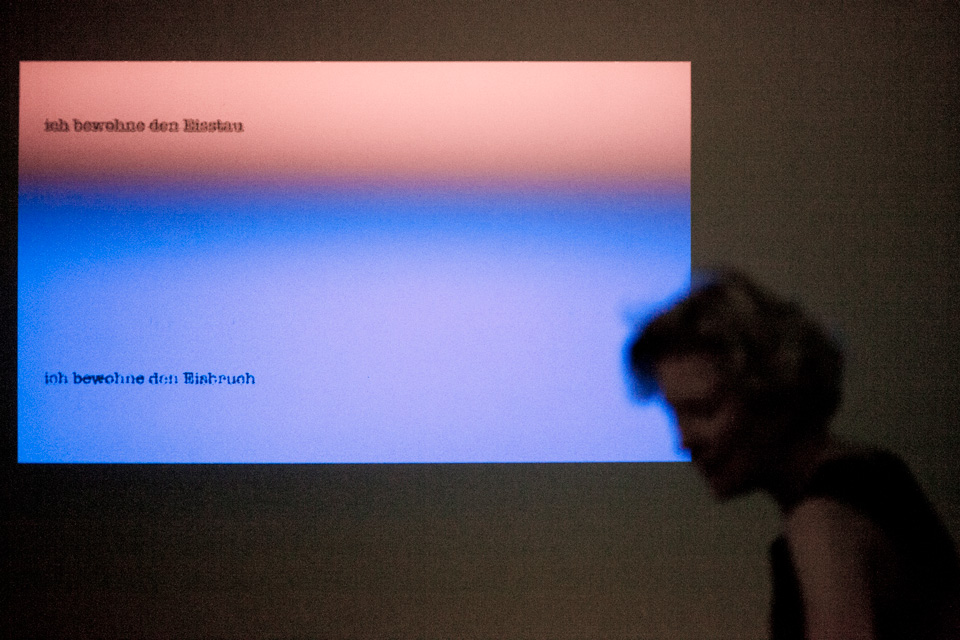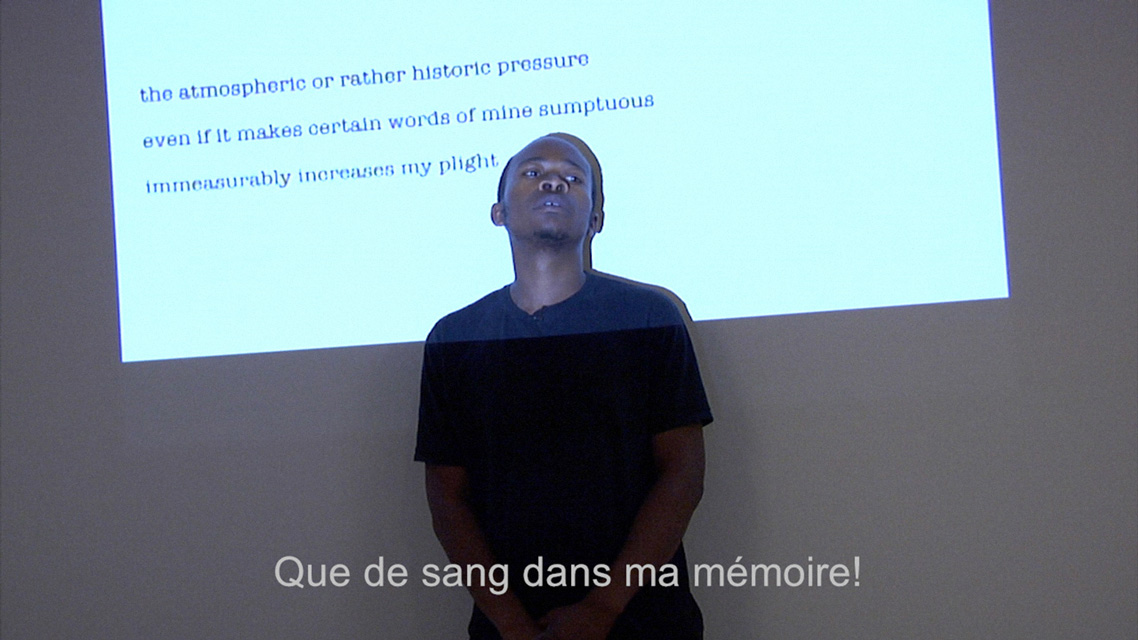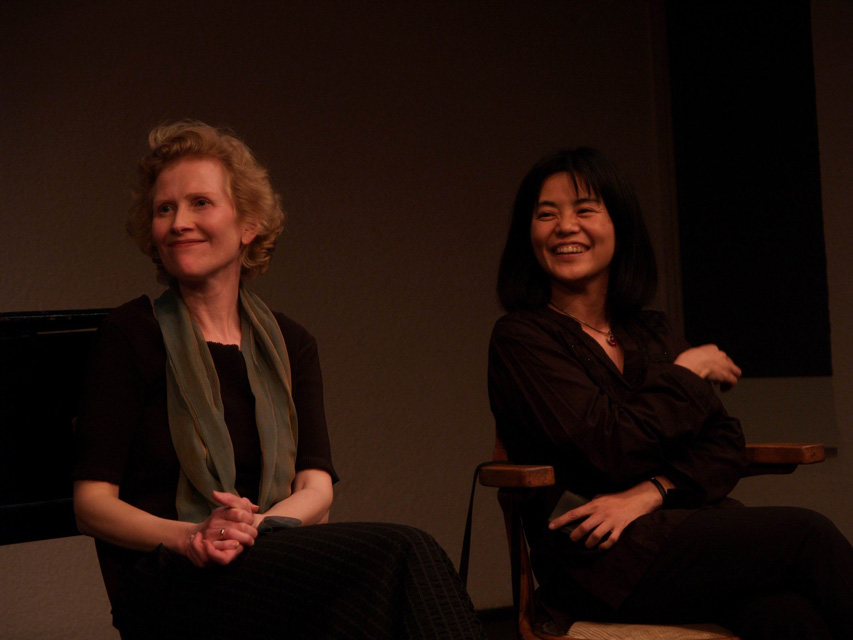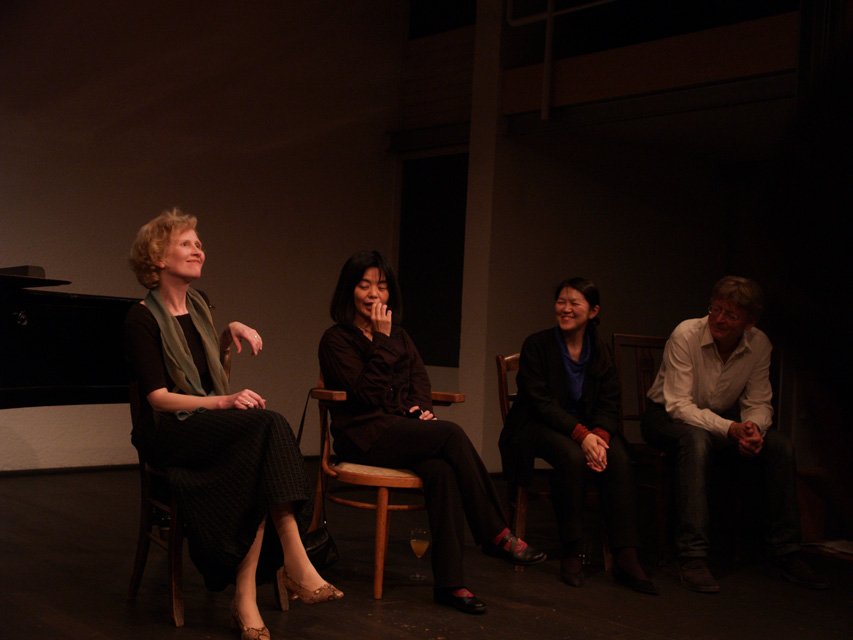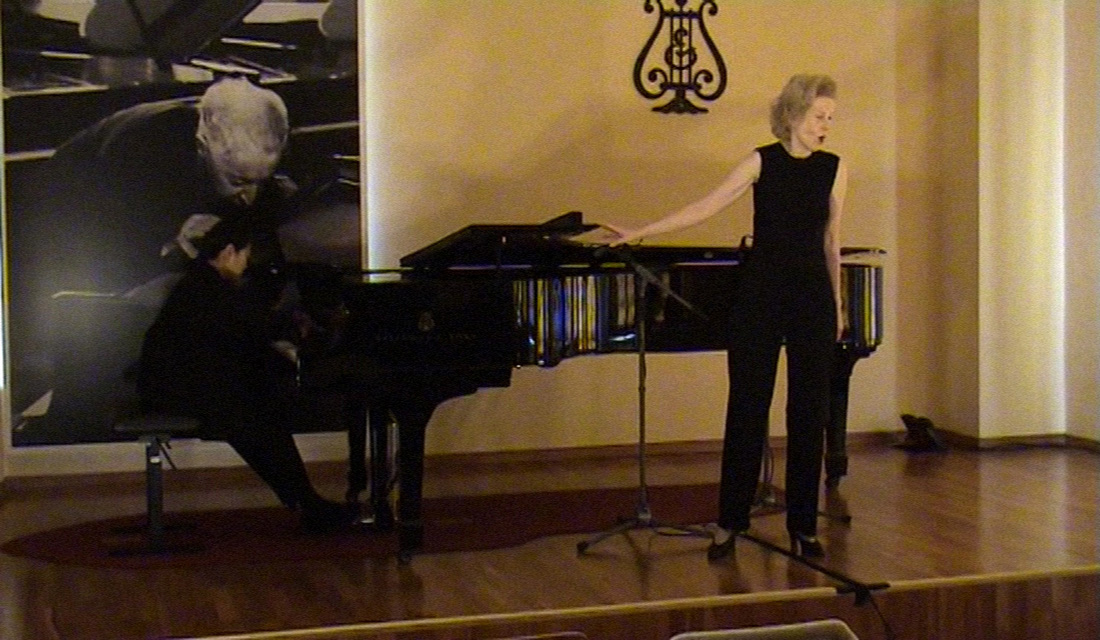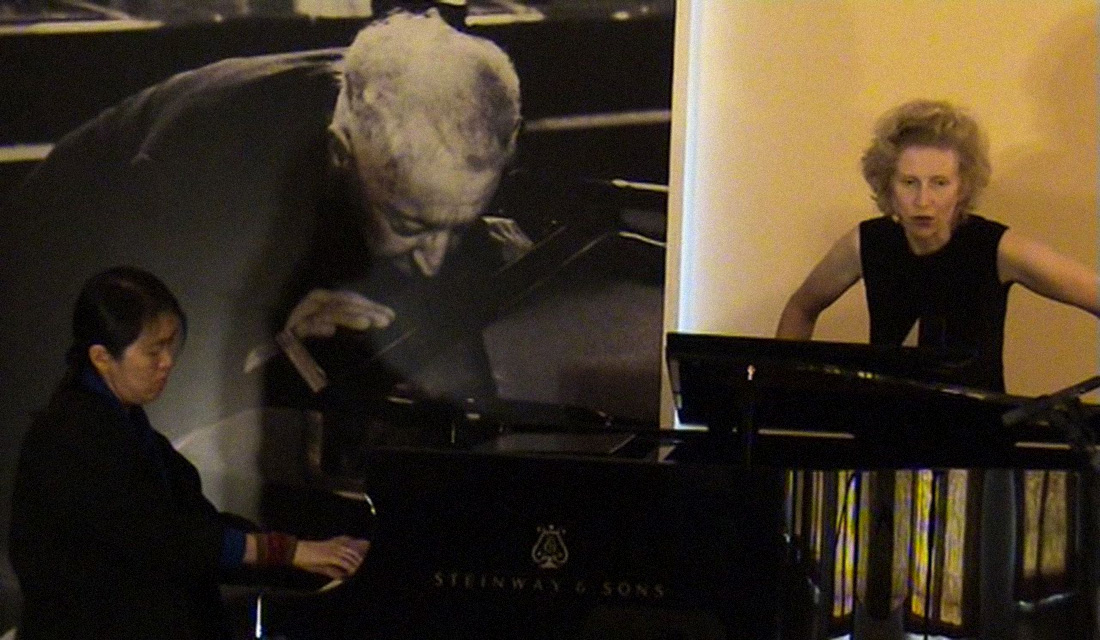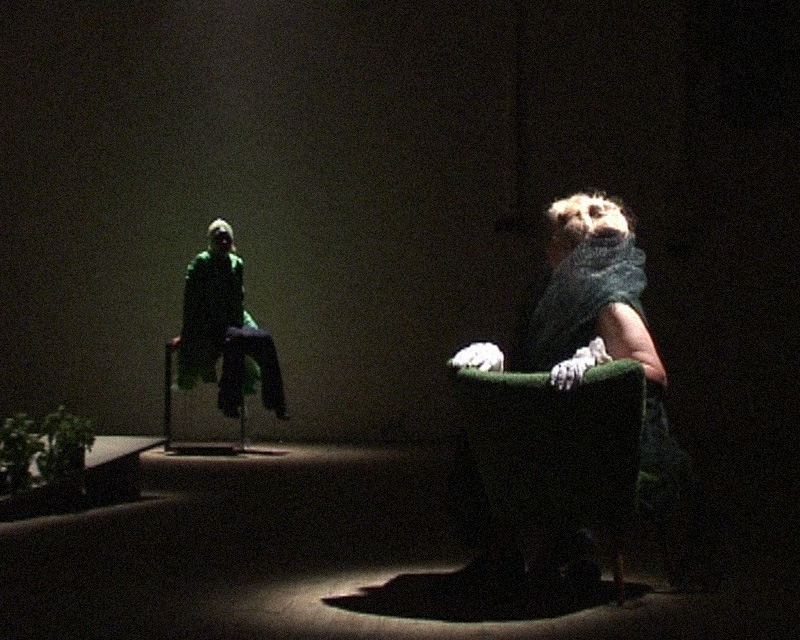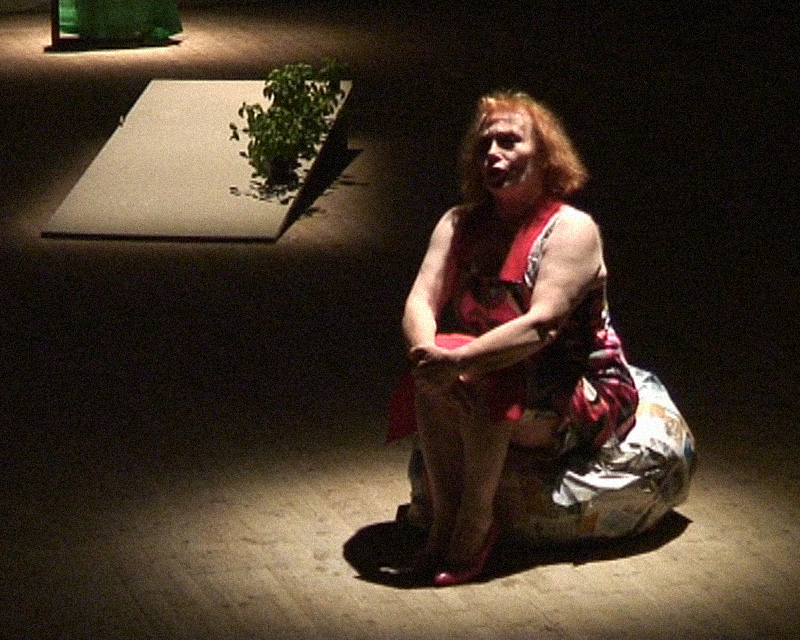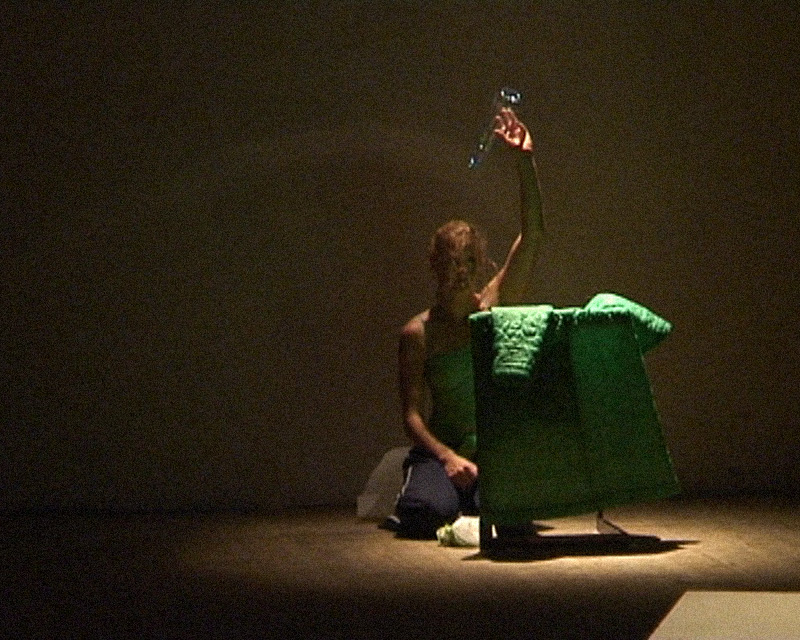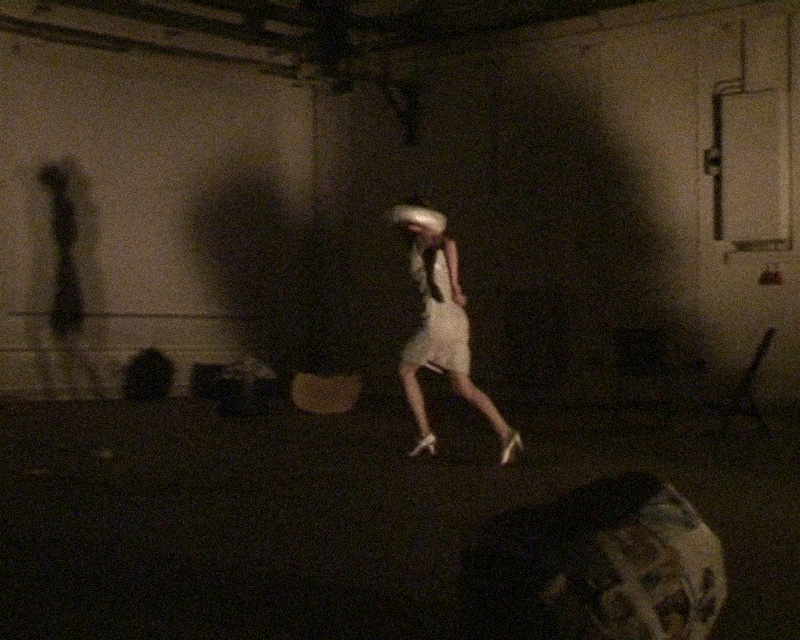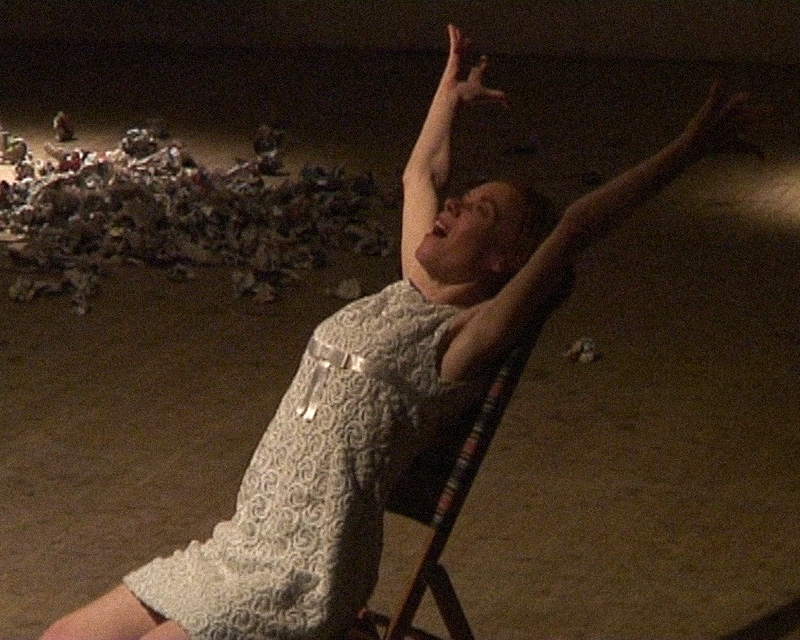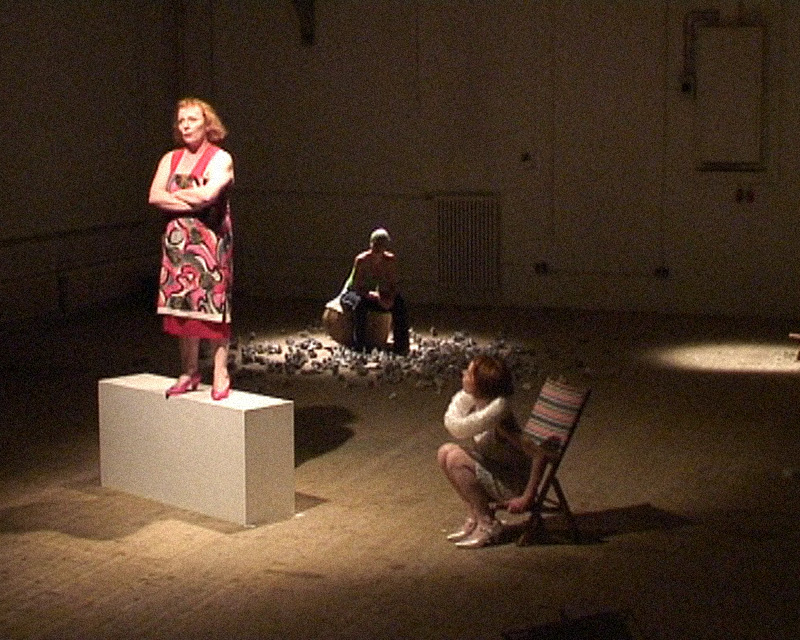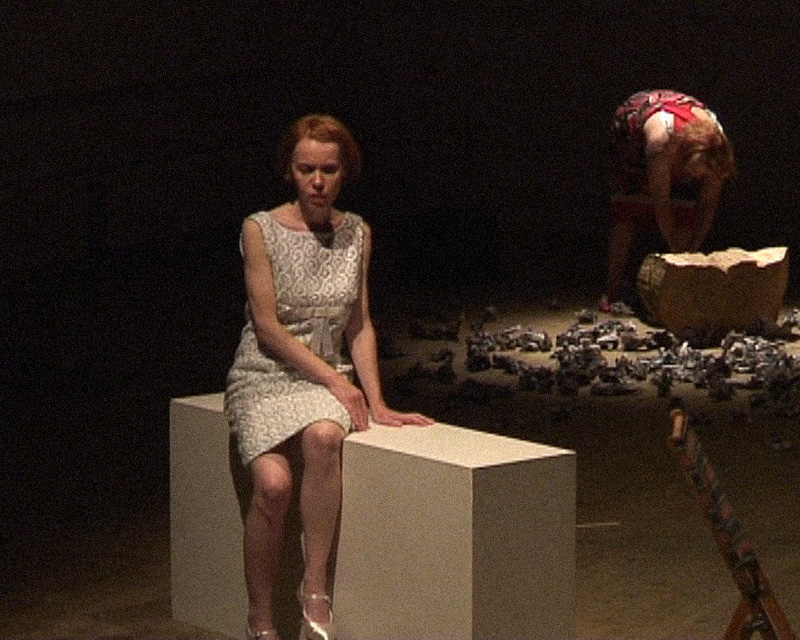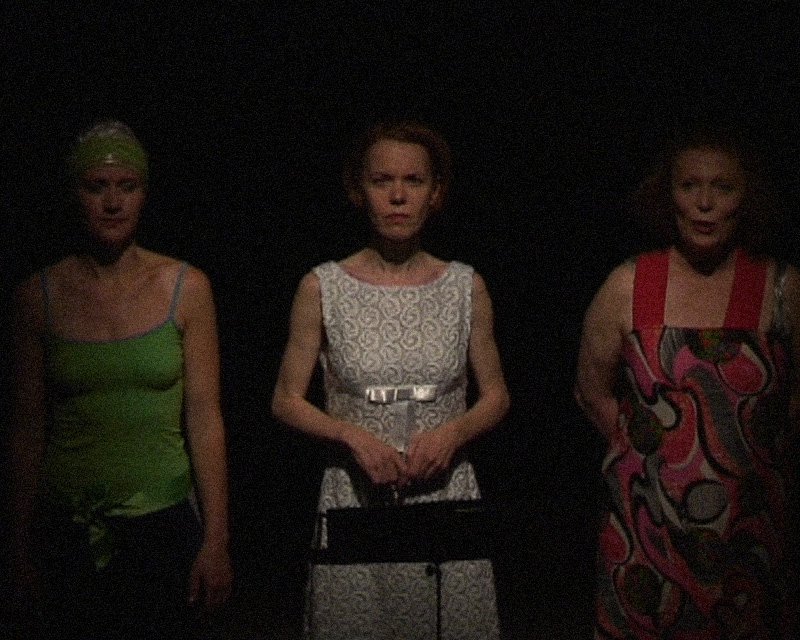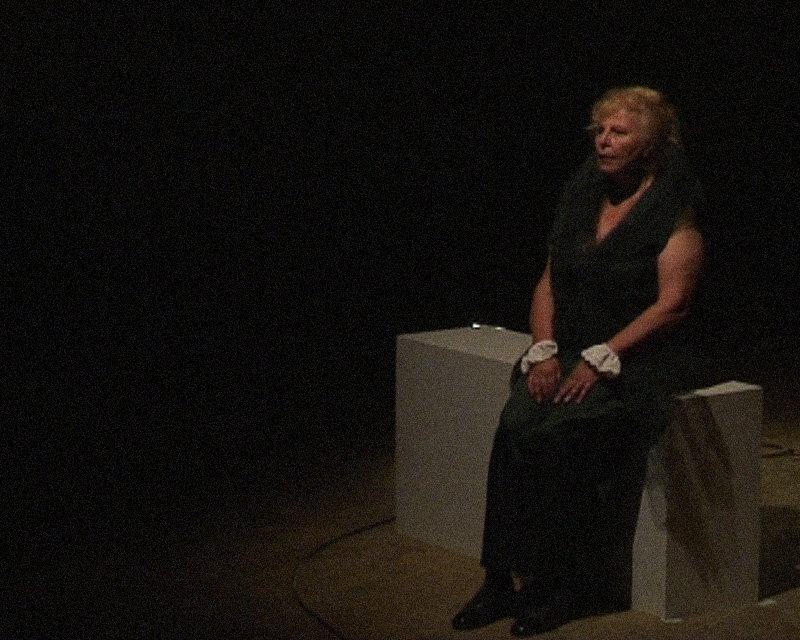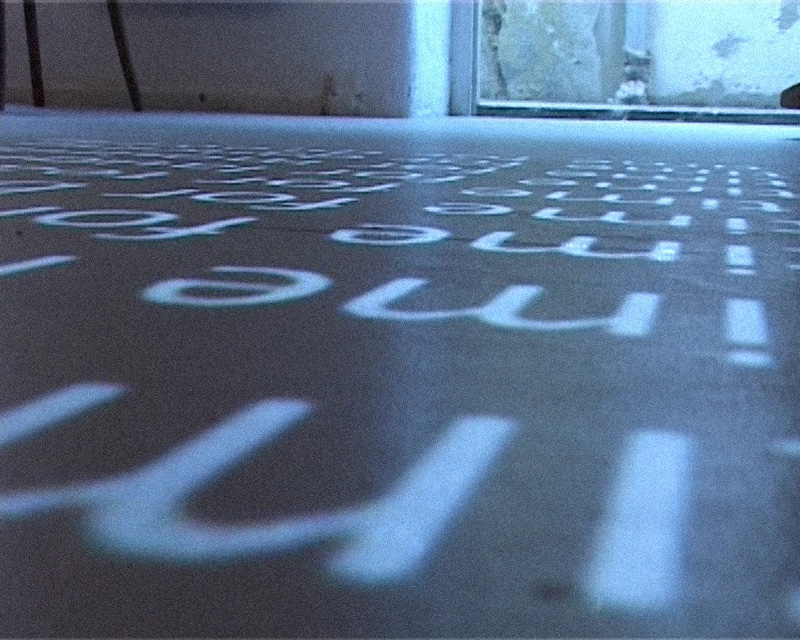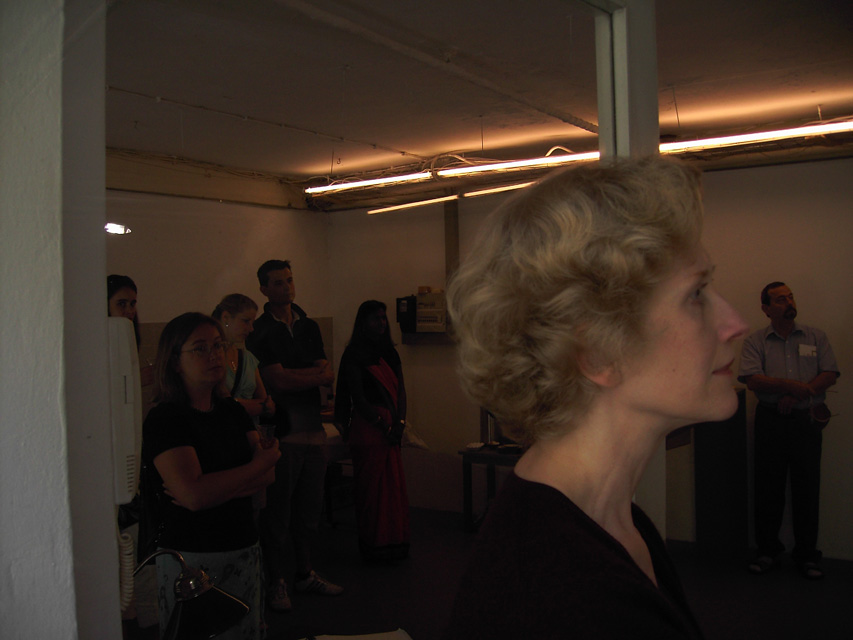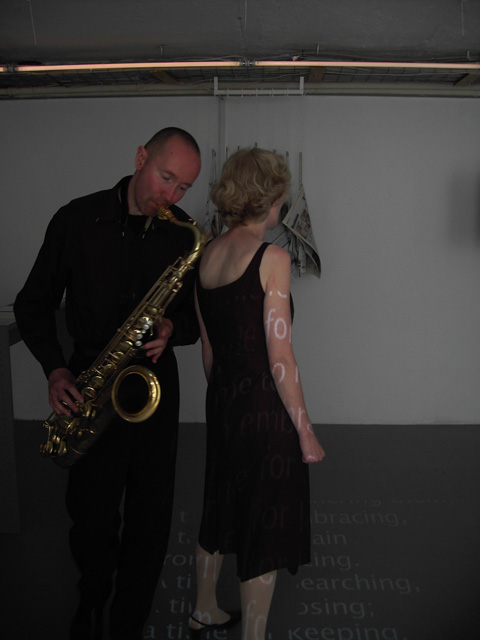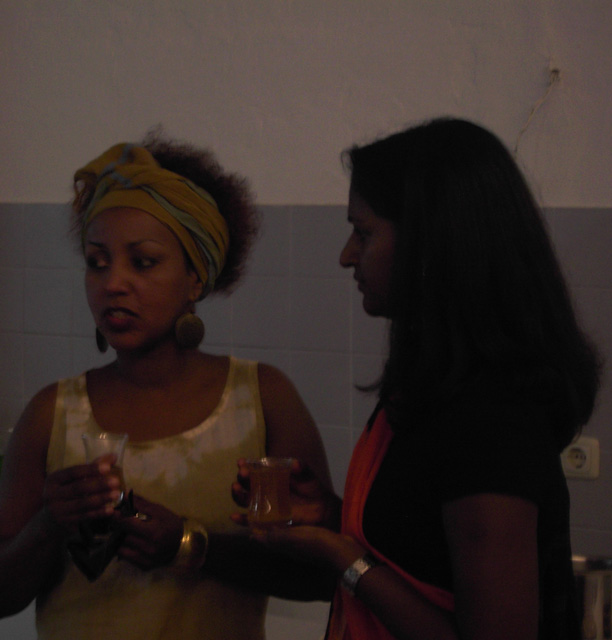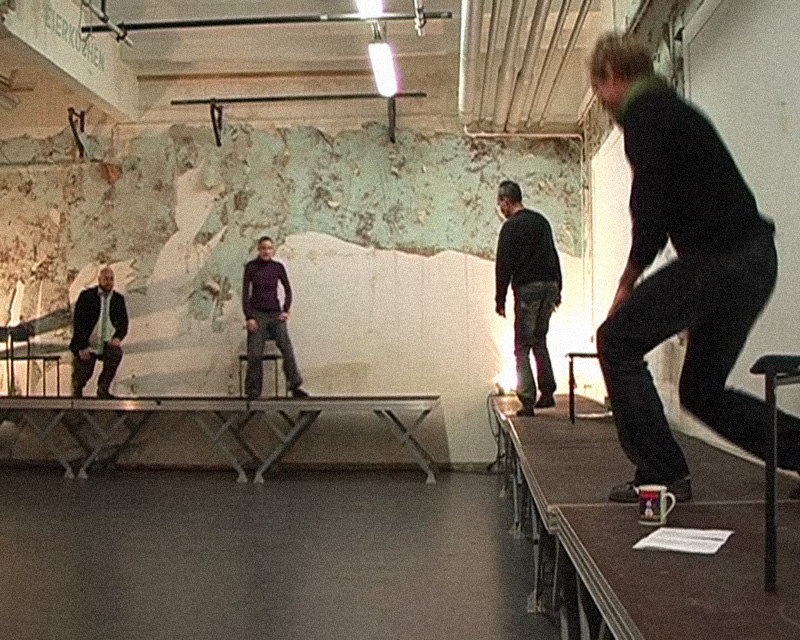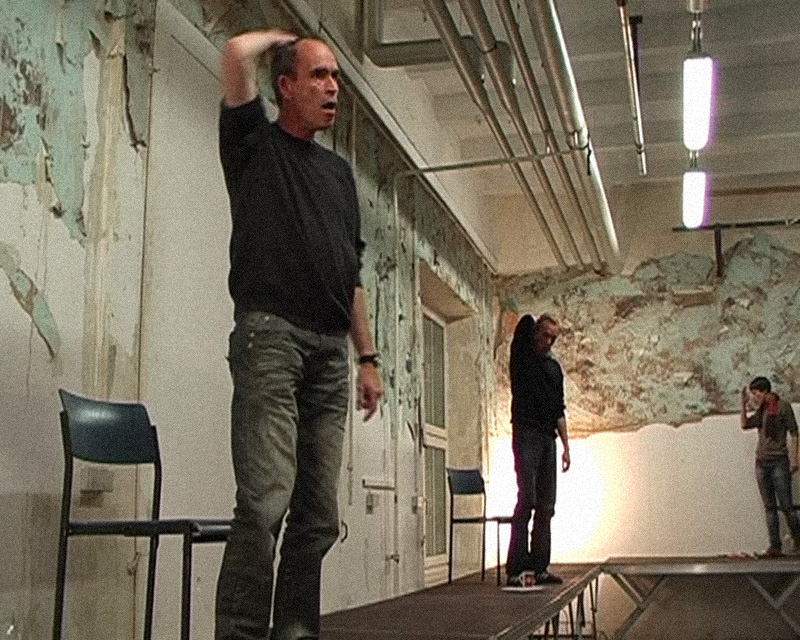Speech Acts 2007-2021
The video shows excerpts from works by Tomma Galonska with herself as performer. (Partly in English or with English subtitles.)
An adaption of »The Persians« by Aeschylus
This 2500 year old tragedy describes the victory of the Greeks over the world power of that age, Persia. It is a founding myth of Europe. I invite the audience to discover the text in five steps from five perspectives. And I transform the varieties of spatial settings in a large performance room. The central visual element is a large red square on the floor which seems to separate the audience space from a wide, empty space.
The play begins with the victory fantasies of the Persians. These of course are meant to help them stifle their fear of defeat. The evocations are spoken bit by bit by an actress, unseen. They echo through the room while the audience looks into a wide, empty space.
The second stage is a discursive inquiry regarding the humanistic interpretive tradition of "The Persians". Could it have been enjoyable to experience a lamenting world power on stage? The actress, now mingling with the audience, shows through the historical facts that the gruesomely detailed war reporting in the messenger's account less likely focused on any sympathy with the vanquished (as is often claimed) than on a collective celebration of this Greek "David-victory" over the Persian "Goliath".¹
In part three, the actress takes on the role of the vanquished. Expressing the horror becomes an act of mourning. The voice carefully touches on the words. A lengthy listening follows each lamentation. Intimacy in tone and time-space is linked in such a way that the ancient words of lamentation seem near and far alike. The red square is the focus of this event.
In the fourth part, this space, where till now no acting has taken place, is revealed to the audience as a time-space for their reflections, their memories or their actions. In the last stage, all congregate where the red square was. They sit at tables, eat chocolate (symbolic for a funeral party) and relate to each other as well as to newly arrived guests what happened here.
Comp. Staiger, Emil: Aischylos: Die Perser. Stuttgart 1993.
Solo for one actress with participation of the audience
Concept and speech-composition
Tomma Galonska
Duration
5x 45 min. for five consecutive days (or on one day with breaks)
German translation used
Heiner Müller and Peter Witzmann
English translation
P. J. Blumenthal
Performances
Klangraum Düsseldorf 2017; Kunstausstellung 6:9 Weltversprechen München 2017
Languages of presentation
German and English
Sponsor
Cultural Department of the City of Munich
And the reflection of the world
Dante Alighieri was the creator of one of the most powerful pictorial poetic feats of language we know. Can his Commedia serve today as a "program" for our own production of images? The Commedia is a 700 year old poem, a report about a journey. The narrator and wanderer, Dante, recounts his path through the worlds beyond. The Commedia is written in eleven syllable Italian tercets: a total of 14,233 verses. Is it possible to recite this work today? And why present it?
"All of Dante's expressiveness is held together by a phonetic construction: an infinitely variable rhythmic pulse adaptable to anything he wanted to convey. The rhythm always moves forward. Each moment is dancing and the dance never stops."¹ Through the objectivity of the structure, everything is treated equally: amusing details (and Dante loves details) and theological maxims, political struggles and some trivial unpleasantries, harrowing agony and the height of spiritual experience, everything beats to the same rhythm. It is this unique way of reflecting on the world that determines the performance motive: waiving all interpretation, the speaker allows all events and verbal images to come to life, a rhythmic lapping of waves which allows for an affective physical experiencing of the tale.²
The prose rhythm of Hartmut Köhler's impressive German translation allows for a light accentuation. The listener is invited, step after step, to follow the pursuit. After each tercet (three verses) there is a brief pause. A hearkening, an inner vision is possible. The Commedia fulfills its purpose when the listener too becomes a wanderer.
Each canto is framed by a short introduction and a few lines from the original Italian version.
James, Clive. In: Clive James on translating Dante. The Telegraph Book News. 2013.
Comp. Gumbrecht, Hans Ulrich: Rhythmus und Sinn. In: Medialität der Kommunikation. 1988.
Solo for one speaker
Concept and speech-composition
Tomma Galonska
German translation used
Hartmut Köhler
English translation (for reading along)
Allen Mandelbaum
Duration
35-45 min. per song
Setting
Variable
Performances
Klangraum Düsseldorf 2019
»Galonska's Divina Commedia is a powerful spiritual exercise that reinvigorates Dante's text as a collective act of mourning and hope. Her enunciation of the prosodic rhythms of the German translation produces vibrant rhythmic novelty while her searing and reflective silences give listener's the mental and emotional space to consider what it might mean to be damned or saved in these dark times.«
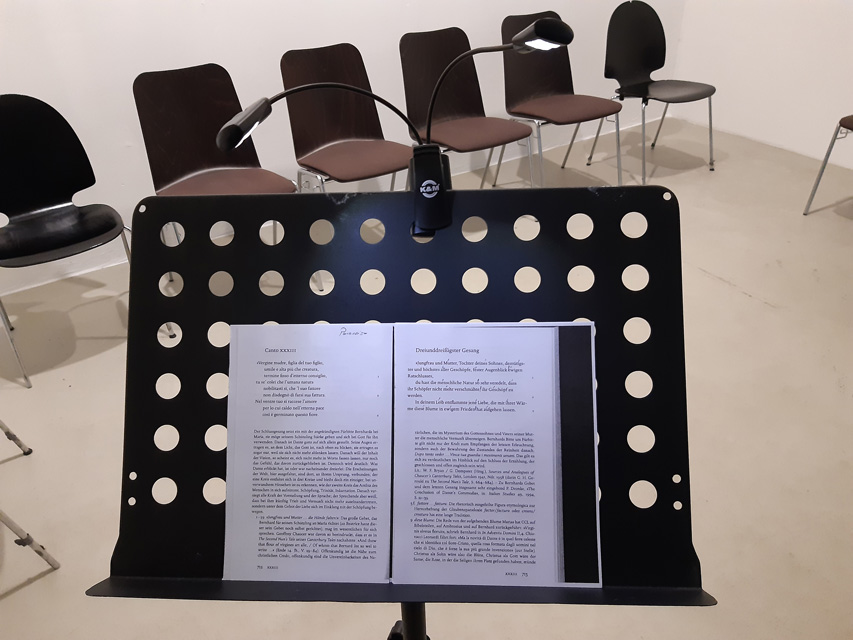
Adaptation of Shakespeare's Henry VI (Parts II and III)
William Shakespeare's "Henry VI" (1590–92) recounts the gory "War of Roses" (1455–85). A brutal poetic work which can also pass as an insightful historical work because in it articles of faith, formulas for our thought and action, have been handed down. The Shakespeare translator Frank Günther claims: "We are dealing here with history rendered through language."¹ Curses, the pathos of war, a mentality of territorial claims, everything, including oaths of love revolve around a single question: victory or defeat? My motive: to create space for verbal violence, thus making visible what was constitutive for the characters (us).
The text reads like a log book for wartime brainwashing. It's subject is explicitly the power words have over us.² What to do with those formulas? I am neither interested in repeating the story of the struggle for annihilation through fiction nor showing characters who are consistent. Preferably, a field of tension should develop that evokes the indoctrination and imperatives of an effective textual legacy while simultaneously removing any possible identification, thus allowing the language of violence to crumble. I choose a speech methodology which allows abstraction and figuration to merge.
A two-room installation was set up for the presentation. The actress is sitting alone in a small chamber; the audience can look into that room through a door but not enter it. In the visitors' room, a video projection shows the face of the artist growing more and more blurred. In the space of an hour, the actress has gone deep into her own physical experience of language, experimenting verbally with this cruel and yet so poetic glorification of violence. For brief moments, you can discern the characters behind the rearing verbal cascades and the slogans of destruction. Through this verbal show a play about war is presented in which no one is performing anymore.
Visitors are allowed to change seats. Different angles offer different options in the combination of visual and acoustic information.
Comp. Günther, Frank: Heinrich VI, 2. Teil, pp276. Cadolzburg 2010.
Comp. Günther, Frank: Unser Shakespeare, pp233. München 2014.
Speech composition for a single female voice (or ad libitum)
Concept, libretto and Performance
Tomma Galonska
Duration
60 min.
Settimg
A two-room installation
German translations used
August Wilhelm Schlegel, Frank Günther
Video-Installation
Manuela Hartel
Performances
Leonrod Haus für Kunst München (Atelier Anne Wodtcke) 2014
Sponsor
Cultural Department of the City of Munich
Adaption: »I live in hell – let me live«
Video-Diptych by Manuela Hartel
Screenings
Leonrod Haus München 2014; Munich Opera Festival »Stadt der Frauen« München 2015; Collateral event of Biennale Arte »Body & Soul« Venice 2017
"The staging is radical: Tomma Galonska displays subversive furor and a dream of a better world."
"An interesting experiment in language and speech which transforms the viewer in about an hour into an intense listener and observer."
26 days of performing – Poetry by Aimé Césaire
Aimé Césaire (1913-2008), was an Afro-Carribean poet, one of the founders of Négritude¹ and a politician. His poetry is an affirmation, an homage to a life in which everything is connected: poetry as a power that connects humans with the cosmos² and likewise a political act. Driven by "the urgency to create a free and righteous society, Césaire's poetry unleashes"³ in every line a struggle for political liberation. He shows us how to unleash the spirit, feelings and perceptions through verbal expression.
The performance can be seen in the context of my occupation over many years with oral traditions in the African cultural sphere. I don't mean by that oral traditions of tales and sagas but rather a comprehensive concept of language as a "principle of action".4 This idea results in a dynamic concept with respect to the relationship between a written text and its performance. I address this in a cycle of presentation: concretizing speech in a written form (demonstrated through a video projection), and thus interlocking the opulence of variety when texts are rendered orally. Consequently, the venue for the production (Haus der Kunst), itself steeped in history, is transformed into a visual medium and – thanks to its tremendous echo – also into a sounding box for a political outcry: "Europe patrols my veins like a swarm of filariae at the stroke of midnight."5
The performers (a European woman and an African man) arrive daily at 13:13 hours (symbolic of another way of perceiving time) und deliver "poetic news". The poetry of Césaire is an invitation to a dialogue with the world of diversity. Technical language from geology and botany, Latin words and his own invented words provide an insight into a complex image of the world and are likewise a space for Césaire's painfully explosive descriptions of his own historical experience.
Each day, the performers explore afresh the messages in the poetry. All at once, viewers are confronted with the concrete situation of the black African performer living in Europe who plays with their expectations and asks all at once: "Do you want me to dance for you?"
Négritude is a framework of critique and literary theory, developed mainly by francophone intellectuals, writers, and politicians of the African diaspora during the 1930's, aimed at raising and cultivating "Black consciousness" across Africa and its diaspora. Wikipedia.
Comp: Jahn, Janheinz. Aimé Césaire: Sonnendolche. Heidelberg 1956.
Leiris, Michel. In: Aimé Césaire – Gedichte. München 1987.
Hampâté Bâ, Amadou: Das Wort überbrückt Jahrhunderte. In: Imlfeld, Al: Verlernen was mich stumm macht. Lesebuch zur afrikanischen Kultur. Zürich 1980.
Césaire, Aimé: At the Lock of the Void. In: Solar Throat Slashed. Engl.: Clayton Eshelman
Poetic News
Texts by Aimé Césaire
lagoonal calendar (calendrier lagunaire) from: i, laminaria (moi, laminaire); Solar Throat Slashed (Soleil Cou Coupé); Return to my Native Land (Cahier d'un Retour au Pays Natal); Lost Body (Coprs Perdu); et al.
Concept
Tomma Galonska
Duration
26 days (1h per day)
Venue
Haus der Kunst, Munich
German translations used
Janheinz Jahn, Brigitte Weidmann, Klaus Laabs
English translations used
Clayton Eshleman, Annette Smith
Performer
Tomma Galonska, Tonderai Munyebvu
Sculptures
Valentin Manz
Science adviser
Danila Roth
Languages of presentation
German, English, French
Sponsors
Cultural Department of the City of Munich; District of Upper Bavaria; Freie Münchner und Deutsche Künstlerschaft, FMDK e.V.
Documentation
NEWS 13:13 Video documentation
Film recordings of days 14 and 15
With English subtitles
Adaption: »supreme mask«
Performance in honor of the 100th birthday of Aimé Césaire
Solo for one performer, Munich 2013
"By interweaving voices that open into various languages while artists and audience move about in the room establishing a context for Césaire's poetry, Tomma Galonska creates a performance which enables the poetry to move through time and space. This is a new way to approach the place the poet speaks about: "I inhabit an exploited space."
By Yoko Tawada – Poetry as a dialogue between voice and piano
The Japanese writer Yoko Tawada has been living in Germany since 1982 and writes most of her texts in German and "describes the world the way it would look if you were awake and dreaming at the same time" (taz). Tawada's poetry and short prose-poetry are among the earliest texts I got interested in when exploring new forms of recitation. Two motifs came to the fore: first the associatively playful way a Japanese writer used the German language and the surprising connections in meaning she created; and secondly, the question: how to convey vocally the fact that the text does not differentiate between dream and reality?
Together with the Japanese pianist Masako Ohta, I turned the laws of music improvisation into text vocalization. There are no clear rules about how the text should sound. Instead, the performers get into the text in a fresh way for each performance and convey the resulting impulses immediately as voice and sound production:
"A towel / a Turk wears it on her head / the wind takes it up / and lays it on the belly of the cross /a linen towel / when it's dark at the movies / the towel steps down from the cross / and flies into the kitchen / and dries."¹
The speaker and the pianist are infected by this poetically bizarre scenario: the speaker sticks to the text stubbornly, takes risks though by stretching sounds, changing tempos and voice frequency, even allowing for repetitions. Sometimes you first hear vocal noises and phonemes alone which then unfold into words or sentences. The pianist reacts to the text via rhythm, melody fragments, noises. Together they create a meaning-sound-fabric where statements are transmogrified, sounds and words affecting each other and a continually oscillating space for perception and meaning is created. In short: A world comes into view where dream and reality cannot be separated.
Tawada, Yoko: »Die Oragngerie« In: Aber die Mandarinen müssen heute Abend noch geraubt werden.
Dialogue between voice and piano
Text by Yoko Tawada
Über-See-Zungen; Nur da wo du bist da ist nichts; Aber die Mandarinen müssen heute Abend noch geraubt werden; Wo Europa anfängt.
Concept
Tomma Galonska (voice) and Masako Ohta (piano)
Setting and duration
Variable
German translations
Peter Pörtner
Language of presentation
German (partially Japanese)
Venues
Meta Theater Moosach, Residenz Eichstätt - Art-Spaces Bavaria; Seidlvilla Munich et al 2007-2008
Sponsor
Cultural Department of the City of Munich; Art-Spaces Bavaria (Kunsträume Bayern)
"If words were to become visible: When Tomma Galonska recites texts, something beyond recitation takes place: she turns words into rhythms, presents them as noises, dissects them into individual letters. The variability of her voice is unbelievable. She works with amazing emotional transitions and maintains her credibility. At the conclusion, you have the feeling not only that you've heard something new but that you've seen something new."
A poetic cycle by Andrea Heuser as a process of memory
Andrea Heuser's poetic cycle revolves around childhood memories: fleeting euphoria and a tragic event never clearly defined. Heuser "puts fragile moments into words just before they disappear" (FAZ) allowing memory to speak in its own voice: free of distortion, beautiful and disturbing, frail fragments emerging, and then, suddenly, a passionate delight in verbalizing, and subsequently the soft voice of intimate reflection.
Entering the process of memory is likewise the motivation for the presentation. How does memory work? Images, expressions, impulses assail you. Something out there partakes of a clarity; something else cannot be grasped clearly until it reveals itself as a coherent thought...
Four women of various ages and from the three provinces of theater, acting, dance and song, confront the text as a field of experience. They pursue the associative narrative styles inherent in the poems through speech, movement and song fragments. They forge a childlike connection to nature in cascades of words:
"Let all be neckwards, be heaven- WHOOSH, wish and"¹
The dancer feels these experiences in body movement; and the composer Sidney Corbett has created a pitch for a mezzosoprano, weaving ephemeral tones and fearful inklings into the process of memory.
The visual artist Anne Wodtcke has set up the stage with sculptural elements: plants, wood, slanting levels, a giant mountain of crumbled paper. The sober reflections of the narrator serve as a contrast to the sensual submersion into the world of memory. She asks: "What have you seen?'' The word "suicide" is never used and is nevertheless all-present. Forgoing an unambiguous story enables the audience to discover its own traces and experiences in this poetic tale.
Choreography for dance, speech-acts and song-fragments
Text
Andrea Heuser
Concept and director
Tomma Galonska
Composer
Sidney Corbett
Stage design / Light design
Anne Wodtcke / Pit Schultheiß
Actors
Gabi Geist, Inge Rassaerts
Mezzosoprano
Martina Koppelstetter
Dance
Anna Holter
Co-Producer
Schwere Reiter Musik, Karl Wallowsky
PR and production management
Claudia Illi
Sponsors
Cultural Department of the City of Munich; District of Upper Bavaria; Cultural Foundation of the Stadtsparkasse Munich
Adaptation: Concertante (Voice and Mezzosoprano)
Voice: Tomma Galonska, Mezzosoprano: Martina Koppelstetter. 2010-2016
"The audience can experience poetry anew as a harmony of momentary perceptions and associations."
A memorial event
The Old Testament verse "There is a time for everything" from the Book of Kohelet (Ecclesiastes, approx. 250 BCE) addresses the eternal contradictions of life: birth and death, love and destruction, loss and gain, war and peace – with an equanimity that seems to transcend all cultural differences. I've placed this ancient text at the center of an eight-hour memorial event. (Originally conceived for the victims of the bombing in the London tube in 2005.) The goal was to create a setting that interrupts any possible argumentative dispute in order to unite people from various cultures as a community.
Two customs rooted in almost all cultures are combined in a single public space: the celebration of a ritual text and drinking tea with others. In accordance with their own local customs, people from an intercultural neighborhood serve tea. A time schedule is posted indicating when each tea ceremony will take place. The venue for the performance was in the Maxvorstadt area of Munich, and tea was served from places like Mongolia, Ethiopia, Russia, Japan, Turkey – but likewise English breakfast tea and Bavarian mint-lemon balm tea.
Every 15 minutes a gong sounds and one of the twenty-eight lines from Ecclesiastes is intoned by a voice and instrument combination, as an improvisation of around two minutes. Then more tea is served. People talk or remain silent. Participants may come and go or return. The language of the performance is English. Other languages are also possible.
12 hours: There is a time to be born. 12:15 hours: And a time to die. 12:30 hours: A time for planting. 12:45 hours: And a time for uprooting what has been planted [...] 16:00 hours: A time for searching. 16:15 hours: And a time for losing [...] 19:45 hours: There is a time for war. 20:00 hours: And a time for peace.
Walk-in-performance
Text
Book of Kohelet (Ecclesiastes)
Concept
Tomma Galonska and Helena Hill-Wilson (2006)
Revision: Tomma Galonska (2015)
Duration
8 hours (Noon – 8 p.m.)
Venue
Public cultural hall or art gallery
Cast
2 voices, 2 instrumentalists, people from the neighborhood
Performers (Munich 2006)
Xavier Bour (Trumpet) Margarita Holzbauer (Viola da Gamba, Cello) Tomma Galonska (Voice) Michael Mahn (Saxophone and Voice)
Video
Gisela Wunderlich, Bernt Engelmann
Language of presentation
English
First performance
Kunst im Karree (ateleir of Tomma Galonska), Munich 2006
Walk-In Installation for Speech-Acts
"How can you live without knowing your rights?" That's what an old Kurdish war song (530 BCE) asks and continues asking: "But who rules over us?" Possible answers: "The messenger of anger? The lords of fright and fear? Forgiveness, or maybe love or the power of divine might, revenge?"¹
Together with an interdisciplinary ensemble I created a scenario for this text in which the struggle against rulership is performed as a striving for subjective expression. Line for line the performers break through the contingent of verbal forms of expression sanctioned by a society and rebel against the intrinsic (re)production of the structures. By merging body movement and musical elements, we experiment with parameters that have not been turned into clichés. Lines are sung, stuttered, celebrated, fragmented into phonemes etc. A momentum evolves through the individuality of the performers and finally converges into a fabric of divergent artistic articulations.
Simultaneously, these individual struggles for freedom constitute a new collective power. Whatever an individual produces is repeated in chorus.
The entirety is organized as an action loop in a special installation constructed on several levels for the audience to enter into.
Alte kurdische Kampf- und Liebeslieder. Gesammelt und übertragen von Hilmi Abbas. München 2004.
Walk-in-performance
Text
Kurdish Song (anonymous, 530 BCE)
Concept and director
Tomma Galonska
Duration
Loop (ad libitum)
Cast
Ad libitum (speakers, singers, instrumentalists, dancers)
Performers (2009)
Sophie Engert, Stephanie Felber, Leo Gmelch, Sandra Hilpold, Almut Koch, Martin Pfisterer, Marcus Widmann, Thomas Wenke
Stage design / Light design
Tomma Galonska and Anne Wodtcke / Pit Schultheiß
Co-Producer
Schwere Reiter Musik, Karl Wallowsky, München
PR and project management
Claudia Illi
Language of presentation
German
Sponsors
Cultural Foundation of the Stadtsparkasse Munich;
Cultural Department of the City of Munich;
District of Upper Bavaria
"Gnawing question, precious answer: Galonska lets her performers look for some physical access to the text, unsystematically well planned. The language grows continually more abstract, playful, nonsensical. And amazingly, through the refusal to settle on an interpretation, the content of the text attains a sparkling clarity."
